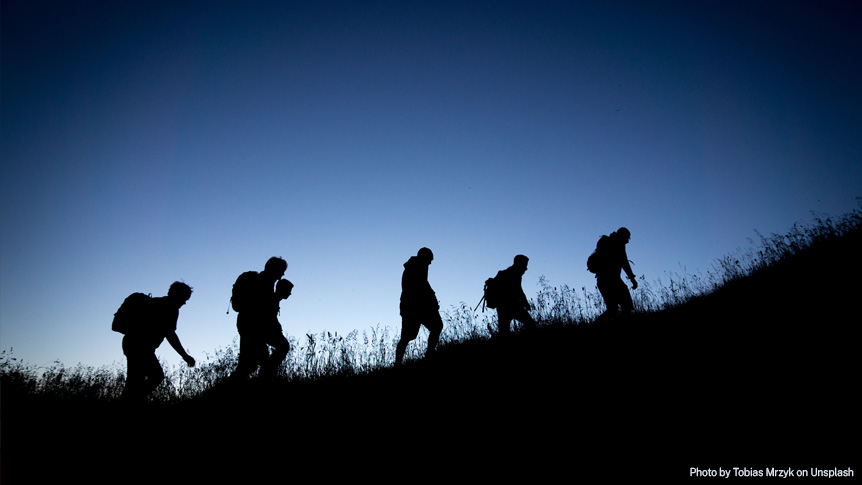what’s already happening at ANU and how can we improve?
Did you know that teamwork is so important in all kinds of employment, including research, that there’s now a “science of team science” (National Research Council, 2015) with its own professional association (International Network for the Science of Team Science)? The science of team science draws on research and experience from a range of fields to provide solid guidance for how to undertake teamwork successfully – from what you need to take into account in forming teams, to helping teams work together effectively, to managing inevitable disagreements and conflict.
As an aside, teamwork and groupwork are used here interchangeably – something that I note not everyone would agree with.
Giving undergraduates a head start in acquiring skills and experience in teamwork is therefore a no-brainer both for enhancing employability and in meeting the graduate attribute “Capability to Employ Discipline-based Knowledge in Transdisciplinary Problem Solving.” So what’s already happening at ANU when it comes to teaching teamwork? What room is there for improvement and where are the greatest needs? Can we imagine a future where teamwork teaching across ANU is so well coordinated that all undergraduate students have a seamless experience in building teamwork skills that steadily increase across the time-course of their degrees?
I was fortunate to be awarded one of the new ANU Strategic Learning and Teaching Grants to make a solid start in answering these questions. My grant “Cementing ANU’s Leadership in Education for Transdisciplinary Problem Solving: Strengthening Teamwork and Scoping Other Characteristics” takes a whole-of-ANU approach and builds on the best research evidence, including research undertaken at ANU. As well as collating research evidence, it involves interviewing academic and professional staff, students and alumni from each College about teaching teamwork.
As you can see from the grant title, my focus is on transdisciplinary problem solving and the critical teamwork skills that involves. In particular, transdisciplinary problem solving requires an ability to work with a range of people who are different – people with different world views, different ideas of what constitutes good research, different values and interests, different cultural backgrounds, and different personalities (for an overview of these differences, see Bammer (2022)). Such differences need to be recognised, appreciated and harnessed in teamwork.
While understanding diversity is important in teamwork, much more is required, including:
- understanding general principles, such as the importance of trust and a safe space
- how to form effective teams, including through setting shared expectations
- leadership, management and facilitation skills, and
- understanding and working with team dynamics, such as:
-
- understanding that teams often go through a series of stages, referred to as “forming,” “norming,” “storming,” “performing,” and “adjourning” (Clayton, 2020; Tuckman 1965)
- being able to manage the “groan zone” as teams transition from divergent to convergent thinking (Kaner, 2014; Kappel, 2019)
- facility with fair decision-making processes, such as “gradients of agreement” (Kaner, 2014, Love, 2021).
As part of the grant, working groups will be convened to develop primers, PowerPoint slide decks and video teaching materials as resources for students during and after their degrees, as well as for ANU educators.
Reviewing and supporting the teaching of teamwork in undergraduate courses is a first step in systematically reviewing ANU education for all the components of transdisciplinary problem solving. If you haven’t already seen it, the ANU framework for transdisciplinary problem solving is presented in the figure below. Teamwork skills sit in the interactive characteristic.

The ANU Framework for Transdisciplinary Problem Solving (Bammer et al., 2023) Design credit: The figure was designed by Alice Wetherell from the Population Health Exchange (PHXchange) in the National Centre for Epidemiology and Population Health.
I am excited to be working on this ground-breaking project and with this blog post am launching a SharePoint site which is the access point for resources gathered and developed in this project. I’d love to hear from you at Gabriele.Bammer@anu.edu.au, if you are interested in:
- discussing your research
- being interviewed about your teamwork teaching or learning
- joining a working group to develop teaching resources in the second half of 2024
- access to the SharePoint site.
December 2023
Professor Gabriele Bammer, National Centre for Epidemiology and Population Health, ANU College of Health and Medicine.
References
Bammer, G. (2022). Understanding diversity primer.
Bammer, G., Browne, C.A., Ballard, C., Lloyd, N., Kevan, A., Neales, N., Nurmikko-Fuller, T., Perera, S., Singhal, I., van Kerkhoff, L. (2023) ‘Setting parameters for developing undergraduate expertise in transdisciplinary problem solving at a university-wide scale: a case study’ Humanities and Social Sciences Communications 10, 208
Clayton, M. (2020) What is The Tuckman Model - Tuckman Team Development Model?
Kaner, S. (2014). Facilitator’s Guide to Participatory Decision-Making (Third Ed.). San Francisco, California: Jossey-Bass.
Kappel, C. (2019) Collaboration: From groan zone to growth zone.
Love, H. (2021) Gradients of agreement for democratic decision making.
National Research Council. (2015). Enhancing the Effectiveness of Team Science. Committee on the Science of Team Science, N.J. Cooke and M.L. Hilton, Editors. Board on Behavioral, Cognitive, and Sensory Sciences, Division of Behavioral and Social Sciences and Education. Washington, DC: The National Academies Press.
Tuckman, B.W. (1965) ‘Developmental sequence in small groups’, Psychological Bulletin, 63, 384–399

